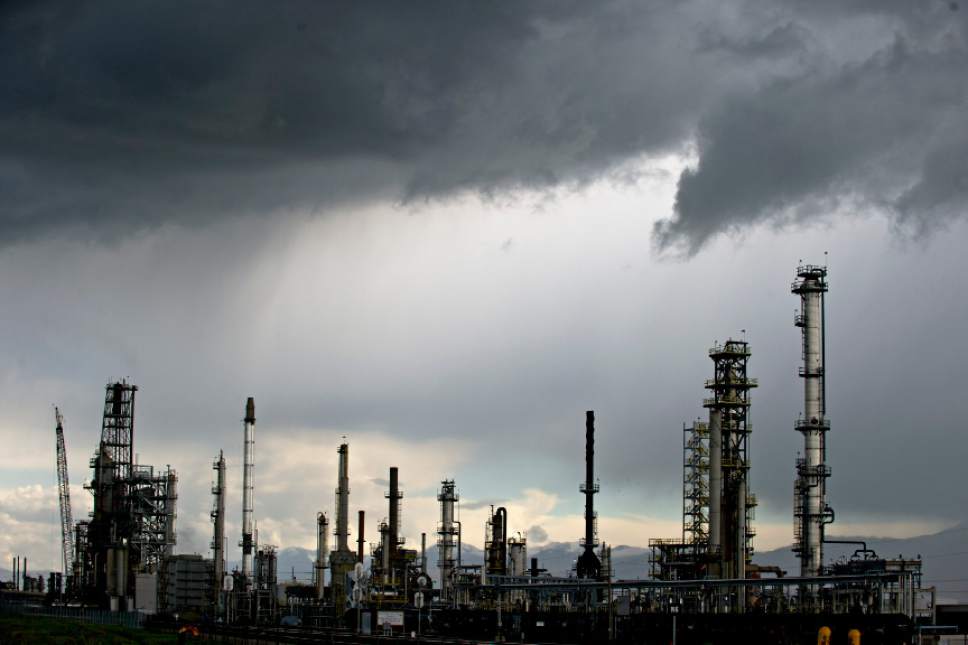This is an archived article that was published on sltrib.com in 2015, and information in the article may be outdated. It is provided only for personal research purposes and may not be reprinted.
Though touted as an important step toward protecting vulnerable communities throughout the U.S., local advocates question just how large an impact the EPA's new rules on refinery emissions will have in Utah.
The rules, which were finalized by the EPA on Tuesday, set new limits on certain toxic pollutants emitted by petroleum refineries, require additional controls for emergency releases and visible flares, limit the number of emergency releases that may occur in a calendar year, and outline the first-ever policy on "fence-line" emissions monitoring. U.S. refineries, including those located in Salt Lake and Davis counties, will be expected to comply with the rules by 2018.
When fully implemented, the EPA estimates that the new rule will reduce the release of toxic chemicals by 5,200 tons per year nationwide. Emissions of volatile organic compounds (VOCs) are expected to decrease by 50,000 tons per year, and greenhouse gas emissions are projected to drop by 660,000 tons per year.
Many of the nation's 150 petroleum refineries are located near residential neighborhoods, and the rules were designed to reduce the health risks associated with those areas, said EPA Administrator Gina McCarthy.
"This final rule accomplished that and much more," McCarthy said at a news conference Tuesday. "Families deserve to be safe from pollution in their backyards."
But local regulators are skeptical that the EPA rules will have a significant impact beyond those regulations already put in place by the state. Bryce Bird, the director of the Utah Division of Air Quality (DAQ), said the most notable requirement in the new rule was the regulation of open-flare emissions — smoke and chemicals emitted by the visible flames shooting out of refineries. But, he said, the state's plan to regulate PM 2.5 (particulate matter deemed hazardous to human health) already called for similar controls to be installed by 2018.
"In that respect, it is a big benefit, but it is something we already required as part of our state plan," he said.
Bird said the EPA and the DAQ arrived at the same requirement by coincidence. The EPA rules, he said, take aim at a large class of toxic air emissions known to cause significant harm to human health, some of which also happen to be volatile organic compounds. The DAQ rule intended to reduce the VOCs because of the role scientists believe the compounds play in the formation of both PM 2.5 and ozone.
The interesting wild card in the EPA's mix of rules is the first-of-its-kind fence-line monitoring requirement. Under the new rule, a refinery will be required to install 12-24 air quality monitors that encircle the facility and collect data on the kinds of emissions that area leaving the refinery site. Janet McCabe, acting assistant administrator for EPA's Office of Air and Radiation, said the rule was included based on the concerns of residents who lived near refineries and is intended to detect "fugitive emissions" that may escape leaking tanks or pipes and that may not be detected in regular emissions testing.
Because there has been little fence-line monitoring conducted in the past, it is not clear exactly what the monitors will detect, or how those reports might impact future emissions controls. But, Peacock said, local refineries are not opposed to the idea.
"Concentrations in and around the fence lines is good data to have," he said.
But Brian Moench, president of Utah Physicians for a Healthy Environment, said he was disappointed to see that the EPA did not go further to regulate emissions from refineries. He said he would have liked to see the EPA set stricter emissions standards, prohibit flaring and end all uncontrolled releases, which the new rule limits to three per year.
Moench said the pollutants released by refineries are known to cause increased rates of strokes, heart attacks, cancers respiratory diseases such as asthma, and premature birth in nearby communities. He said refinery emissions also may be linked to obesity, diabetes, Alzheimer's and Parkinson's disease.
Craig Dietrich, a toxicologist with the Utah Department of Health, said there is no state data one way or the other on the occurrence of most of those conditions in the North Salt Lake area. A statistical survey of disease in North Salt Lake conducted between 1976-2011 did find an increased occurrence of colon and anal cancers, bone and joint cancers, melanoma, breast cancer and prostate cancer — but, he said, none of those cancers are associated with exposure to air pollution. Instead, he said, obesity, tobacco use, alcoholism and inadequate exercise are the top risk factors.
"There's no doubt there's air pollution. It's there. When you go by, you smell it," Dietrich said. "I can't say whether it is dangerous, but if you don't take care of your health, you're going to be much more subject to things in your environment.
The implementation of these new rules is still a few years out. But when it does happen, Dietrich said, he believes it will be a great step forward for the health of residents on the Wasatch Front.
In the meantime, Moench said, Utah Physicians will continue to fight for more restrictions on refinery emissions.
"The refineries have tried to portray themselves as minor players in the overall pollution mix, but that's really not the case, and it's particularly not the case in the surrounding communities," he said. "Given their proximity to the most heavily populated part of the state, they really are a significant source of pollution on the Wasatch Front."
@EmaPen



